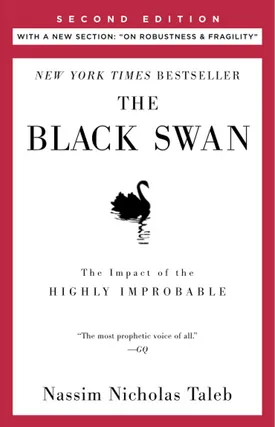The Black Swan: Second Edition: The Impact of the Highly Improbable by Nassim Taleb
Today, a book that has created a great impact on the world of thought, especially on the way people view risk, unpredictability, and events, "The Black Swan: Second Edition: The Impact of the Highly Improbable" by Nassim Taleb is no ordinary book. From students to experienced financial professionals, from interviews to seminars, this book is one of a kind.
To begin with, Taleb introduces and explains his theory about black swans or highly improbable but consequential and unexpected events that defy expectations and cannot be predicted by traditional methods and tools. He calls these unforeseen events “Black Swans”–usually negative, but sometimes positive–because until the Europeans found them in the wild in Australia in the 17th Century, all known swans were white.
Taleb goes on to argue that while the great advances in science, technology, and the global economy have made life more secure, they have also made it more vulnerable to catastrophic events. He argues that while life will always remain subject to critical events of all kinds, our response to such events can help us reduce their impact.
To this end, Taleb refutes the notion that theory and math can be used to predict black swans and argues in favor for the use of risk management strategies, such as the analysis of environments and their dynamics and the use of precautionary principles, to avoid the damaging impacts of these events.
Taleb further explains the concept of stochastic stability and its implications for understanding highly improbable and consequential events. He also talks about how a process called "thick tail" can be used to identify Black Swan events and suggests that combating them requires a knowledge of the probability of their occurrence, as well as strategies for mitigating their potential consequences.
Taleb provides a detailed description of the mechanisms of uncertainty that lead to the occurrence of Black Swans and their related risks. He talks about the implications of these events in various fields, ranging from markets and social sciences to philosophy and history.
Finally, Taleb recommends that mankind should invest more time and effort in learning to recognize and handle the uncertainty associated with Black Swans. He goes on to suggest that individuals prepare for life’s most uncertain times through developing resilience and that organizations develop more robust practices and processes to minimize risk and prepare for important unpredictable events.
In conclusion, The Black Swan: Second Edition: The Impact of the Highly Improbable is a must-read for anyone interested in risk management, finance, economics, or philosophy. Taleb does an effective job of building a framework to understand the concept of Black Swans and their implications for our lives, further stressing the importance of resilience and knowledge in the face of uncertainty. The book is a valuable contribution to the field and a useful reference for those who need to plan for or respond to catastrophic or unexpected events.

